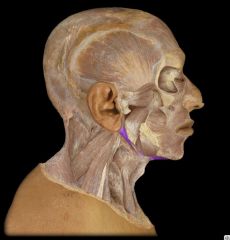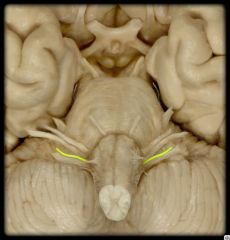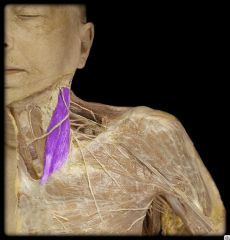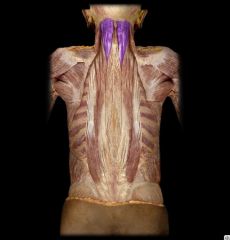![]()
![]()
![]()
Use LEFT and RIGHT arrow keys to navigate between flashcards;
Use UP and DOWN arrow keys to flip the card;
H to show hint;
A reads text to speech;
162 Cards in this Set
- Front
- Back
- 3rd side (hint)

Identify. Spinal chord level? Innervates?
|
Ansa Cervicalis.
C1-C3 Sternohyoid, Sternothyroid, and omohyoid mm. |
|
|

Identify. Drains what? Drains into? Anastomose?
|
Anterior Jugular Vein.
Anterior aspect of the neck. Variable- Subclavian v. or External Jugular v. Often anastomoses between right and left to form a Jugular Venous Arch |
|
|

Identify
|
Cricoid Cartilege
|
|
|

Identify
|
Cricothyroid Ligament
|
|
|

Identify. Innervated? Action?
|
Digastric m. (part of the Suprahyoid muscle group)
Posterior belly - Facial nerve Anterior belly - Mylohyoid nerve (branch of trigeminal nerve) Elevates hyoid and floor of mouth; depresses mandible |
|
|

Identify
|
External Jugular vein
|
|
|

Identify. What two vessels join to form it posterior to the angle of the mandible?
|
External Jugular vein.
Posterior Auricular and Retromandibular veins. |
|
|

Identify. Tributaries. Ends?
|
External Jugular vein.
Posterior Auricular, retromandibular, suprascapular, transverse cervical and anterior jugular veins. Drains into the Subclavian vein |
|
|

Identify.
|
Facial vein
|
|
|

Identify. Tributaries. Ends?
|
Facial vein.
Supraorbital, supratrochlear, angular and deep facial vein. Drains into the Internal Jugular vein (may be joined by the retromandibular vein beforehand and for the Common facial vein) |
|
|

Identify. Components.
|
Glossopharyngeal nerve (CN IX)
GVA, GVE, SVA, SVE, GSA |
|
|

Identify. Component Ganglia.
|
Glossopharyngeal nerve (CN IX)
Inferior Ganglion - GVA + SVA Superior Ganglion - GSA Nucleus ambiguus (medulla) - SVE Inferior salivary nucleus (medulla) - GVE |
|
|

Identify.
|
Posterior 1/3 of tongue.
Special sensory distribution of Glosspharyngeal nerve (CN IX) |
|
|

Identify. Spinal nerve levels. Innervation.
|
Great Auricular Nerve.
C2-C3 Skin behind the auricle and Parotid gland |
|
|

Identify.
|
Skin of and around auricle of ear.
Sensory distribution of Great auricular nerve |
|
|

Identify. Innervation. Action.
|
Hyoglossus m.
Hypoglossal nerve (CN XII) Depression of tongue |
|
|

Identify. Attachments.
|
Hyoid bone.
Body - geniohyoid, mylohyoid, omohyoid and sternohyoid muscles. Greater Horn - middle constrictor, hyoglossus, digastric bellies, stylohyoid and thyrohyoid muscels. Lesser Horn - stylohyoid ligament |
|
|

Identify.
|
Hypoglossal nerve (CN XII)
|
|
|

Identify. Innervations.
|
Hypoglossal nerve (CN XII)
Genioglossus, hyoglossus, and styloglossus muscles. Intrinsic tongue muscles (except palatoglossus - vagus n.) |
|
|

Identify. Component(s)
|
Hypoglossus nerve (CN XII)
GSE |
|
|

Identify. Component and Ganglia.
|
Hypoglossal nerve (CN XII)
GSE Nucleus CN XII (medulla) |
|
|

Identify. Branches from? Supplies?
|
Inferior thyroid artery.
Thyrocervical Trunk. Ascending cervical artery and an inferior branch which anastomoses with Superior thyroid artery. |
|
|

Identify.
|
Inferior thyroid artery
|
|
|

Identify. Tributaries.
|
Internal Jugular vein.
Facial, Lingual, Pharyngeal, Sigmoid sinus, Inferior petrosal sinus, and Superior and Middle thyroid veins |
|
|

Identify.
|
Internal jugular vein
|
|
|

Identify. Drains blood from what regions?
|
Internal jugular vein
Cranial cavity (including brain) Face Neck |
|
|

Identify. Terminates?
|
Internal jugular vein.
Unites with Subclavian vein to form Brachiocephalic vein |
|
|

Identify
|
Left Internal jugular vein
|
|
|

Identify. Describe descending course.
|
Internal jugular vein.
Descends within Carotid Sheath alongside common and internal carotid arteries, vagus nerve (CN X) and lymphatic channels |
|
|

Identify. Innervation. Branch of?
|
Internal laryngeal nerve
General sensation of mucous membrane of larynx superior to vocal folds. Branch of Superior laryngeal from vagus nerve (CN X) |
|
|

Identify
|
Distribution of internal laryngeal nerve
|
|
|

Identify
|
Isthmus of Thyroid
|
|
|

Identify. Origin
|
Left Subclavian Artery.
Arch of Aorta |
|
|

Identify. Branches.
|
L. subclavian artery.
Vertebral, internal thoracic, costocervical trunk, thyrocervical trunk, suprascapular (variable), and continues as axillary artery |
|
|

Identify. Contribution. Innervation.
|
Lesser occipital nerve.
Ventral rami of C2 spinal nerve Sensory - lateral scalp and posterior part of auricle of ear |
|
|

Identify. Innervation
|
Levator scapulae muscle.
Dorsal scapular nerve (Ventral rami C3-4) |
|
|

Identify. Action
|
Levator scapulae muscle
Elevation of scapula and lateral flexion of neck (when scapula fixed) |
|
|

Identify. Origin.
|
Lingual artery
External carotid artery |
|
|

Identify. Branches.
|
Lingual artery.
Dorsal lingual, sublingual, and continues as deep lingual artery |
|
|

Identify. Drainage. Termination
|
Middle thyroid vein.
Larynx, trachea, and inferior portion of thyroid gland. Internal jugular vein |
|
|

Identify. Innervation
|
Mylohyoid muscle.
Trigeminal nerve (CN VIII) |
|
|

Identify. Action.
|
Mylohyoid muscle.
Elevation of floor of mouth. |
|
|

Identify
|
Mylohyoid muscle
|
|
|

Identify. Origin.
|
Occipital artery.
External artery |
|
|

Identify. Distribution.
|
Occipital artery.
Posterior scalp; SCM, digastric, stylohyoid, splenius and longissimus muscles; dura mater; and bone of posterior cranial fossa |
|
|

Identify. Innervation
|
Omohyoid muscle.
Ansa cervicalis nerve |
|
|

Identify. Action.
|
Omohyoid muscle.
Depression of hyoid bone |
|
|

Identify.
|
Omohyoid muscle
|
|
|

Identify. Describe structure
|
Omohyoid muscle.
Has two bellies (superior and inferior) joined by intermediate tendon attached to clavicle by fascia |
|
|

Identify. Innervation
|
Platysma muscle.
Facial nerve (CN VII) |
|
|

Identify. Action.
|
Platysma muscle.
Elevates, creases skin of neck ("horror") and depression of lower lip and angel of mouth |
|
|

Identify. Contribution. Terminates.
|
Recurrent laryngeal nerve.
Vagus nerve (CN X) Within larynx, inferior laryngeal nerve |
|
|

Identify. Composition. Innervates.
|
Recurrent laryngeal nerve.
GVA - sensory, larynx below vocal cord SVE - motor, intrinsic muscles of larynx (except cricothyroid): intrinsic laryngeal muscles: posterior and lateral cricoarytenoid, transverse and oblique arytenoids, aryepiglottic, thyroarytenoid, thyroepiglottic, and vocalis muscles |
|
|

Identify
|
Scalene mm.
|
|
|

Identify. Action
|
Scalene muscles.
Anterior: elevates rib 1; lateral flexion and rotation of neck Middle: elevation of rib 1; lateral flexion of neck Posterior: elevation of rib 2; lateral flexion of neck |
|
|

Identify
|
Scalene muscles
|
|
|

Identify
|
Anterior scalene muscle
|
|
|

Identify
|
Anterior scalene muscle
|
|
|

Identify
|
Anterior scalene muscle
|
|
|

Identify
|
Middle scalene muscle
|
|
|

Identify. Innervation
|
Sternocleidomastoid muscle.
Accessory nerve (CN XI) |
|
|

Identify. Unilateral Action.
|
Sternocleidomastoid muscle.
Rotation of head so face turns to opposite side |
|
|

Identify the muscle and nerve crossing perpendicular to it
|
Sternocleidomastoid muscle and Transverse cervical nerve
|
|
|

Identify. Bilateral action
|
Sternocleidomastoid muscle.
Flexion of head |
|
|

Identify. Innervation.
|
Semispinalis muscle.
Dorsal rami of Cervical spinal nerves |
|
|

Identify. Action
|
Semispinalis capitis muscle.
Unilateral: rotation of head to opposite side. Bilateral: extension of head and neck |
|
|

Identify. Innervates.
|
Spinal accessory nerve (CN XI).
Trapezius and sternocleidomastoid muscle |
|
|
|
226. Vertebral level of hyoid bone
|
CV3
|
|
|
|
227. Vertebral level of thyroid cartilage
|
CV4,5
|
|
|
|
228. Vertebral level of cricoid cartilage
|
CV6
|
|
|
|
229. Muscles that are innervated by CN XI
|
Trapezius, SCM
|
|
|
|
230. Structures that course between anterior and middle scalene
|
Brachial plexus, subclavian artery
|
|
|
|
231. Innervation of omohyoid, sternohyoid and sternothyroid
|
Ansa cervicalis
|
|
|
|
232. Innervation of digastric
|
Anterior belly = CN V
Posterior belly = CN VII |
|
|
|
233. Innervation of carotid sinus and carotid body
|
CN IX, CN X
|
|
|
|
234. Major structures to pass through pharyngeal wall superior to superior constrictor
|
Auditory tube, levator veli, Palatini
|
|
|
|
235. Nerves of pharyngeal plexus
|
CN IX, CN X, Sympathetics
|
|
|
|
236. Only muscle innervated by CN IX
|
Stylopharyngeus
|
|
|
|
237. Structures that pierce thyrohyoid membrane
|
Internal laryngeal nerve, superior laryngeal artery
|
|
|
|
238. Only muscle to abduct vocal cords
|
Posterior cricoarytenoid
|
|
|
|
239. Innervation of cricothyroid
|
External laryngeal nerve
|
|
|
|
240. Innervation of laryngeal muscles exclusive of cricothyroid
|
Recurrent laryngeal
|
|
|
|
241. Muscle that increases tension on vocal cords
|
Cricothyroid
|
|
|
|
242. Sensory nerve to larynx superior to vocal cords
|
Internal laryngeal
|
|
|
|
243. Sensory nerve to larynx inferior to vocal cords
|
Recurrent laryngeal
|
|
|
|
244. Site of aspirated lodged fishbone
|
Piriform recess
|
|
|
|
245. Afferent – efferent limbs of gag reflex
|
CN IX – CN X
|
|
|
|
236. Only muscle innervated by CN IX
|
Stylopharyngeus
|
|
|
|
237. Structures that pierce thyrohyoid membrane
|
Internal laryngeal nerve, superior laryngeal artery
|
|
|
|
238. Only muscle to abduct vocal cords
|
Posterior cricoarytenoid
|
|
|
|
239. Innervation of cricothyroid
|
External laryngeal nerve
|
|
|
|
240. Innervation of laryngeal muscles exclusive of cricothyroid
|
Recurrent laryngeal
|
|
|
|
241. Muscle that increases tension on vocal cords
|
Cricothyroid
|
|
|
|
242. Sensory nerve to larynx superior to vocal cords
|
Internal laryngeal
|
|
|
|
243. Sensory nerve to larynx inferior to vocal cords
|
Recurrent laryngeal
|
|
|
|
244. Site of aspirated lodged fishbone
|
Piriform recess
|
|
|
|
245. Afferent – efferent limbs of gag reflex
|
CN IX – CN X
|
|
|
|
Identify "triangle" location:
Stylohyoid muscle |
Anterior Triangle
|
|
|
|
Identify "triangle" location:
Digastric muscle - anterior belly |
Anterior Triangle
|
|
|
|
Identify "triangle" location:
Digastric muscle - posterior belly |
Anterior Triangle
|
|
|
|
Identify "triangle" location:
Mylohyoid muscle |
Anterior Triangle
|
|
|
|
Identify "triangle" location:
Geniohyoid muscle |
Anterior Triangle
|
|
|
|
Identify "triangle" location:
Sternohyoid muscle |
Anterior Triangle
|
|
|
|
Identify "triangle" location:
Omohyoid muscle - superior belly |
Anterior Triangle
|
|
|
|
Identify "triangle" location:
Thyrohyoid muscle |
Anterior Triangle
|
|
|
|
Identify "triangle" location:
Sternohyoid muscle |
Anterior Triangle
|
|
|
|
Identify "triangle" location:
Suprahyoid muscles |
Anterior Triangle
|
|
|

Identify.
What lies immediately posterior/anterior? |
Sternothyroid muscle.
Thyroid gland/Sternohyoid muscle |
|
|
|
Identify "triangle" location:
Infrahyoid muscles |
Anterior Triangle
|
|
|
|
Identify "triangle" location:
Right Common Carotid artery (Originates?) |
Anterior Triangle
(Brachiocephalic trunk) |
|
|
|
Identify "triangle" location:
Left Common Carotid artery (Originates?) |
Anterior Triangle
(Arch of Aorta) |
|
|
|
Identify "triangle" location:
Carotid Sinus (What vessel is inferior/superior to it?) |
Anterior Triangle
(Common Carotid artery/Internal carotid artery) |
|
|
|
Identify "triangle" location:
Thyroid gland |
Anterior Triangle
|
|
|
|
Identify "triangle" location:
Glossopharyngeal nerve (CNIX) (Through what foramen does it descend into the neck?) |
Anterior Triangle
(Jugular Foramen) |
|
|
|
Identify "triangle" location:
External branch of Superior Laryngeal nerve (What does it innervate?) |
Anterior Triangle
(Cricothyroid muscle) |
|
|
|
Identify "triangle" location:
Superior thyroid artery (Originates?) |
Anterior Triangle
(External Carotid artery) |
|
|
|
Identify "triangle" location:
Internal Jugular vein (Traverses neck enclosed in what structure?) |
Anterior Triangle
(Carotid Sheath) |
|
|
|
Identify "triangle" location:
Transverse cervical nerve (Innervates) |
Branches from cervical plexus at posterior border of SCM and course anteriorly and across to Anterior Triangle.
(Cutaneous innervation of anterior neck) |
|
|
|
Name the structure that forms the narrow roof of the nasal cavity and is pierced by Olfactory nerve fibers in order to descend into the mucus membrane of the nasal cavity.
|
The cribriform plate
|
|
|
|
Name the structure that forms the narrow roof of the nasal cavity and is pierced by Olfactory nerve fibers in order to descend into the mucus membrane of the nasal cavity.
|
The cribriform plate
|
|
|
|
The optic chiasm lies superior to what two structures?
|
The two internal carotid arteries as they enter the cranium and the roof of the pituitary fossa
|
|
|
|
What unique structural difference distinguishes the optic nerve (CNII) from the rest?
|
It is covered throughout its course by all three meningeal layers of the brain: Dura, arachnoid, and pia mater
|
|
|
|
Name the bones that make up the orbit.
|
maxilla, zygomatic, frontal, ethmoid, lacrimal, sphenoid, and palatine bone.
|
|
|
|
These branches of the ophthalmic artery supply the eyelid.
|
Supratrochlear, supra-orbital, lacrimal, and dorsal nasal arteries
|
|
|
|
Lymphatic drainage of the eye is to what lymph node(s)?
|
Parotid and submandibular nodes
|
|
|
|
Which nerves of the Extrinsic eye muscles course through the Common tendinous ring?
|
Levator palpebrae superioris and Superior rectus (Superior branch of oculomotor n.); medial rectus, inferior rectus, and inferior oblique (Inferior branch of oculomotor n.); and Lateral rectus (abducent n.)
The Superior oblique is innervated by the Trochlear n. (CNIV) which courses OUTSIDE of the tendinous ring. |
|
|
|
What components branch from the inferior branch of the oculomotor n.?
|
Nerves to the ciliary ganglion, medial rectus, inferior oblique, and inferior rectus mm.
|
|
|
|
The oculomotor m. provides what kind of fibers to the ciliary ganglion?
|
parasympathetic preganglionic fibers.
|
|
|

Identify. Innervation. Action.
|
Pupillary sphincter m.
Parasympathetic axons from the ciliary ganglion. Close (contract) pupil |
|
|
|
Symptoms and etiology of Horner's syndrome
|
Sx:
1- Miosis: constriction of pupil (resulting from paralysis of dilator muscle of iris). 2- ptosis: drooping of upper eyelid (from paralysis of levator palpebrae superiori branch to superior tarsal plate). 3- enophthalmos: retraction/backward-displacement of an eyeball into orbit (from paralysis of orbitalis muscle. 4- anhidrosis: absence of sweating 5- vasodilation: fllushing. Etiology: Lesions to cervical sympathetics from brain stem stroke, tuberculosis, Pancoast's tumor, trauma, and/or injury to carotid artery. |
|
|
|
Etiology of miosis (constricted pupil)
|
paralysis of pupillary dilator m. from lesion to sympathetic nerves
|
|
|
|
Etiology of mydriasis (dilated pupil)
|
paralysis of pupillary sphincter m. from lesion to parasympathetic nerves
|
|
|

Identify. Innervation. Action.
|
Pupillary dilator m.
Sympathetic axons either from ciliary ganglion or long ciliary nerves. Central opening (dilation) of pupil |
|
|

Identify. What neurological components are housed within this structure?
|

Cribriform plate.
It is perforated by 15 to 20 foramina which transmits the olfactory nerves (CN I) from the olfactory mucosa to the olfactory bulb. |
|
|

Identify. What is transmitted?
|

Posterior ethmoidal a. v. n.
|
|
|

Identify. What is transmitted?
|

Anterior ethmoidal foramen.
Anterior ethmoidal a. v. n. |
|
|
|
What are the key foramina of th Anterior Cranial Fossa and corresponding transmitted structures?
|
Cribriform plate - Olfactory nerves (CN I)
Anterior ethmoidal foramen - Anterior ethmoidal a. v. n. Posterior ethmoidal foramen - Posterior ethmoidal a. v. n. |
|
|

Identify. What two bones form this depression?
|

Nasolacrimal canal/duct.
Lacrimal and frontal process of MAXILLA |
This depression is continuous with the nasolacrimal canal, which leads to the inferior nasal meatus.
|
|

Identify. Innervation
|

Lacrimal gland.
Sensory - neurons return to CNS through lacrimal branch of ophthalmic nerve (V1). Secretomotor - postganglionic parasympathetic fibers from pterygopalatine ganglion. Postganglionic sympathetics from Superior Cervical ganglion along plexus surrounding internal carotid artery. |
The preganglionic parasympathetics arise from the greater petrosal nerve (CN VII). These fibers hitchhike with the Maxillary nerve (V2) at the pterygopalatine ganglion which becomes the zygomatic nerve, then zygomaticotemporal nerve eventually joining the lacrimal nerve.
|
|
|
Baby Girl of 2 months old is brought to pediatrician with complains of irritated left eye, uncontrollable teary eye, and blueish swelling at the infero-medial canthus of the palpebral fissure the same eye. What anatomical issue accounts for the swelling and uncontrollable tearing?
|

Dx - Dacryocystocele.
Caused by a congenital obstruction of the nasolacrimal duct. |
|
|

Identify. The artery that courses through here is a branch of?
|

Supraorbital notch.
The supraorbital artery arises from the ophthalmic artery immediately after it crosses the optic nerve. |
It exit the orbit through the supraorbital foramen with the supra-orbital nerve - it supplies the forehead and scalp as it passes to the vertex of the skull.
|
|
|
What is transmitted?
Cribfriform plate |
CN I - Olfactory nerve
|
|
|
|
What is transmitted?
Anterior ethmoidal foramen |
Anterior ethmoidal a. v. n.
|
|
|
|
What is transmitted?
Posterior ethmoidal foramen |
Posterior a. v. n.
|
|
|
|
What is transmitted?
Optic canal (chiasmatic groove) |
Optic nerve (CN II)
Ophthalmic artery |
|
|
|
What is transmitted?
Superior orbital fissure |
Oculomotor nerve (CN III)
Trochlear nerve (CN IV) Ophthalmic nerve (CN V1) Abducens nerve (CN VI) Superior ophthalmic vein |
|
|
|
What is transmitted?
Foramen rotundum |
Maxillary nerve (CN V2)
|
|
|
|
What is transmitted?
Foramen spinosum |
Middle meningeal a.
Recurrent meningeal nerve (CN V3) |
|
|
|
What is transmitted?
Foramen lacerum |
Meningeal branch of ascending pharyngeal a.
|
|
|
|
What is transmitted?
Hiatus for Greater Petrosal nerve |
Greater petrosal nerve (CN VII)
Petrosal branch of middle meningeal a. |
|
|
|
Hiatus for lesser petrosal nerve
|
Lesser petrosal nerve (CN IX)
|
|
|
|
What is transmitted?
Internal acoustic meatus |
Facial nerve (CN VII)
Vestibulocochlear nerve (CN VIII) Internal labyrinthine a. |
|
|
|
What is transmitted?
Jugular foramen |
Glossopharyngeal nerve (CN IX)
Vagus nerve (CN X) Accessory nerve (CN XI) Sigmoid sinus inferior petrosal sinus posterior meningeal branches of occipital and ascending pharyngeal arteries. |
|
|
|
What is transmitted?
Foramen magnum |
Spinal chord
Spinal roots of Accessory nerve (CN XI) Vertebral artery Anterior and Posterior spinal arteries, Dural veins |
|
|
|
What is transmitted?
Hypoglossal canal |
Hypoglossal nerve GSEs (CN XII)
posterior meningeal branch of ascending pharyngeal artery |
|
|
|
What is transmitted?
Petrotympanic fissure |
Chorda tympani (CN VII)
|
|
|
|
What is transmitted?
Stylomastoid foramen |
SVE of Facial nerve (CN VII)
|
|
|
|
What is transmitted?
Carotid canal |
Internal carotid a.
Sympathetic plexus |
|
|
|
What is transmitted?
Tympanic canaliculus |
Auricular branch of Glossopharyngeal nerve (CN IX)
|
|
|
|
What is transmitted?
Mastoid canaliculus |
Auricular branch of Vagus nerve (CN X)
|
|
|
|
What is transmitted?
Sphenomaxillary fissure |
3rd portion of maxillary a.
|
|
|
|
What is transmitted?
Pterygopalatine fossa |
3rd portion of maxillary a.
pterygopalatine ganglion |
|

